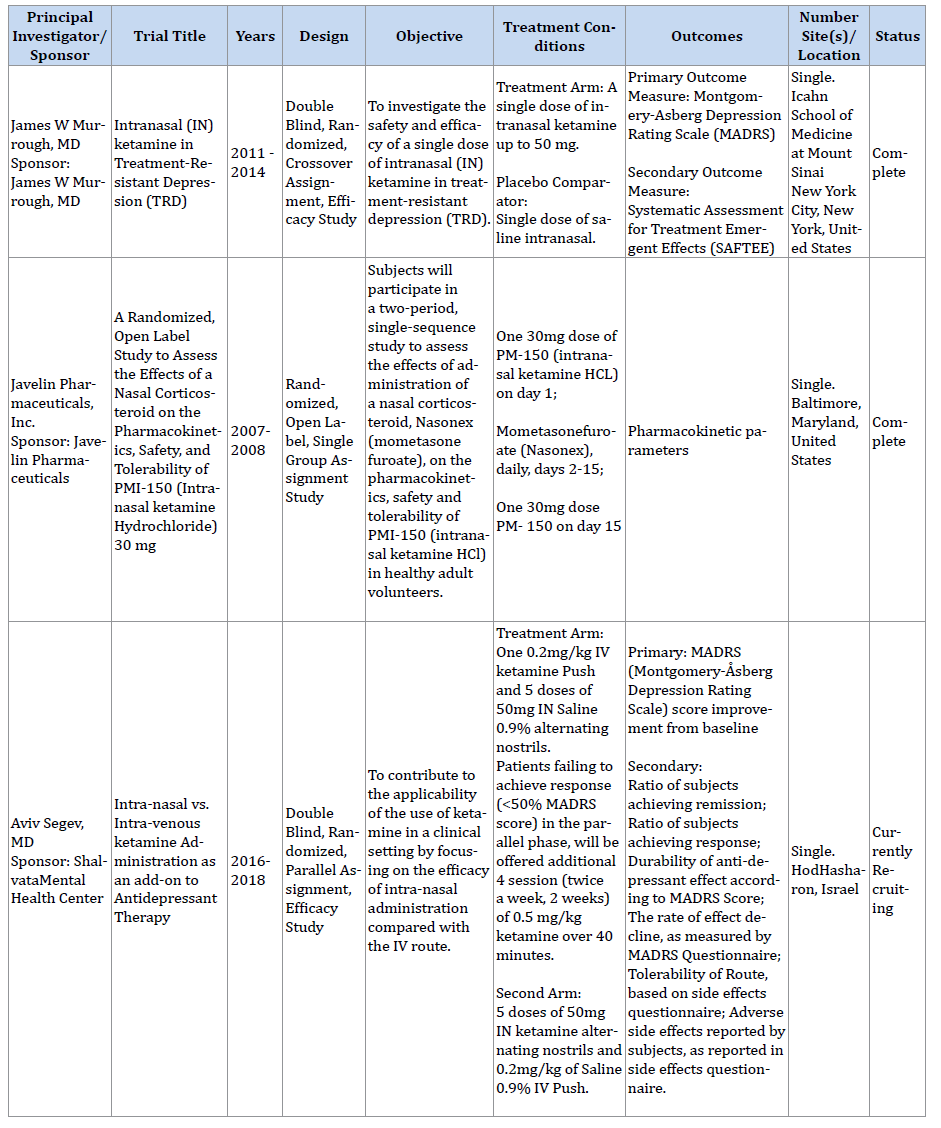AUCTORES
Globalize your Research
Editorial Note | DOI: https://doi.org/10.31579/2637-8892/036
*Corresponding Author: Pai-hanzu, Department of Science,Taoyuan Psychiatric Center, Taiwan.
Citation: Pai-hanzu, (2018) Depression and Suicidality of Intranasal Ketamine: Current Evidence,J.Psychology and Mental Health Care, 2(4); DOI: 10.31579/2637-8892/036
Copyright: © Pai-hanzu. This is an open-access article distributed under the terms of the Creative Commons Attribution License, which permits unrestricted use, distribution, and reproduction in any medium, provided the original author and source are credited.
Received: 06 July 2018 | Accepted: 26 August 2018 | Published: 25 September 2018
Keywords: ketamine; intranasal; depression; treatment-resistant depression; suicidality
Repeated use of IV ketamine infusion for depression and suicidality is not practical for some of patients. Thus, the objective of this report is to describe the current and forthcoming trials investigating Intranasal (IN) ketamine. We conducted a search of PubMed and clinical trials. Gov. There is one published, randomized, double-blind trial and five clinical trials in clinicaltrials.gov: two completed, two recruiting, and one withdrawn. IN ketamine is potentially a promising and practical alternative to IV infusion. Data is still limited, however the results of these ongoing studies could provide helpful clinical guidance regarding efficacy and adverse effects.
Ketamine has long been recognized as an anesthetic by the medical community, especially in children [1]. Occasionally, it has been used instead of standard anesthetic for Electroconvulsive Therapy (ECT) administration in patients with high seizure thresholds [2]. Recently, ketamine has also been utilized in sub anesthetic doses for Treatment-Resistant Depression (TRD) in unipolar and bipolar depression, in both open-label [3,4] and randomized trials [5–10]. It has further been shown to probably be efficacious for suicidal ideation [11]. The evolving and spreading use of IV ketamine in psychiatry (mainly TRD) has been attributable to its relative safety in short term use [12]. Ketamine’s efficacy using IV infusion has been shown in several clinical trials [13,14].
This efficacy, however, is transient and usually does not last beyond 1–2 weeks. Thus, repeated IV infusions, several times a week, are needed to prolong the duration of response [15]. This repeated IV infusion is a barrier to treatment as it is not a very practical strategy, especially for patients who need a continuation phase due to frequent relapses on conventional antidepressant medication. Thus, Intranasal (IN) ketamine administration might be a more practical strategy, with fewer barriers to treatment. IN ketamine still offers a fast acting administration that avoids digestion in the gut and bypasses the blood-brain barrier through the olfactory epithelium via the cribriform plate [16].
Due to the utility and ease of use of IN ketamine compared to IV ketamine, it is an interesting candidate for further investigation, both for efficacy and its potential adverse effects. Therefore, this article summarizes published and ongoing studies of IN ketamine that are forthcoming for depression or suicidality. We found that there are no published or ongoing studies that have examined IN ketamine for suicidality as the primary outcome.
We conducted a PubMed search of clinical trials for IN ketamine use in depression from inception to February 14th, 2017. We used the following combination of terms: intranasal ketamine, depression, depressive disorders, or treatment resistant depression. The search identified only one published, randomized, double-blind study examining the efficacy of intranasal ketamine hydrochloride for TRD. Lapidus et al. (n = 20) examined ketamine HCl as an adjunctive therapy from 2012 to 2013 in a crossover design [17]. This crossover study compared IN ketamine HCL versus saline solution as placebo. The primary outcome was change in Montgomery-Asberg Depression Rating Scale (MADRS) administered 60 minutes prior to and 40, 120, and 240 minutes, as well as 1, 2, 3, and 7 days post ketamine administration.
The dosage of intranasal ketamine in this study was 50 mg total (delivered as 10 mg × 5 puffs over a period of 20 minutes) administered under the supervision of anesthesiologist. Participants included 10 men and 10 women who were 48 (+/- 12.8) year-old Caucasians.
The ketamine dosing was well tolerated by all participants with minimal psychotomimetic or dissociative effects and no clinically significant hemodynamic changes. Participants in the IN ketamine group had significant improvement in depressive symptoms at 24 hours compared to those in the placebo group (t = 4.39, p < 0>p = .033).
Studies using IV ketamine described in the literature showed 64% response rate [8], however, it is hard to compare across studies as other factors might explain the difference in response.
One of the limitations of this double-blind study is that the dissociative properties of ketamine might have an unblinding effect. Another limitation, inherent in the crossover design of the study, is that the carry-over effect cannot be fully ruled out. The literature is very limited so far for IN ketamine. Although the published study provided some evidence of feasibility and possible efficacy, it had a small sample size and is not definitive
Although Lapidus et al. [17] is the only published study, there are several ongoing studies of IN ketamine for depression that can give the reader the breadth of research and forthcoming data in this area. We identified these studies by searching clinicaltrials.gov using the previously mentioned key terms. These ongoing studies are summarized in table 1.

Table 1: Intranasal Ketamine for Treatment of Suicidality and Treatment-Resistant Depression Pipeline/Nonpublished Clinical Trials (from clinicaltrials. gov).
IN ketamine seems to be a promising alternative to IV infusion of ketamine and more practical to use, especially in intermediate and long-term use. However further data are needed to guide clinical use. The results of these ongoing studies could provide helpful information regarding efficacy and adverse effects. The potential of addiction-related adverse effects with longer-term IN ketamine especially needs further research attention for risk-benefit analysis considerations in clinical use.